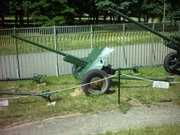
Anti-tank gun is a gun designed to destroy armored vehicles. In order to penetrate the armor of tanks and other armored vehicles, it fires high-velocity shells.
Prior to World War II, anti-tank guns were relatively small, with anti-tank rifles primarily used for destroying tanks. Few had calibres larger than 50 mm. With the rapid improvement in tank armor and guns, anti-tank guns increased in calibre, firing larger shells at greater velocities. One of the most widespread and successful of these was the
German 88 mm gun, which was originally developed as an anti-aircraft gun but later found widespread use in destroying tanks. Likewise, by the end of the war, all sides were using guns with diameters of 90 mm and up.
World War II also saw the mounting of antitank guns on vehicle chassis, sometimes armored, as a cheap substitute for a full-fledged tank. Some had open turrets, while others did not have rotating turrets at all, meaning that the whole vehicle had to be rotated to aim the gun. Americans called these vehicles tank destroyers.
At the start of World War II many of these weapons were still being used operationally, along with a newer generation of light guns that closely resembled their WWI counterparts. In combat both proved entirely useless against the larger and better armored tanks they faced. For instance, the German army had recently introduced a new lightweight 37-mm gun, whose users quickly nicknamed it the "armored door knocker" because all it seemed to do was announce its presence.
All combatants quickly introduced newer and more powerful guns, and the anti-tank rifle had largely disappeared by 1942. The "average" gun by 1943 was 50 mm or larger, the Germans had an excellent 50-mm high-velocity design, while the British introduced the "6-pounder" which was also adopted by the US Army as the 57 mm. A year later, sizes had grown due to pressure on the Eastern Front, German guns were now 75 mm and the famous
88 mm. The Soviet Red Army used a variety of general-purpose 100-mm and 122-mm guns. The British 17 pounder was less at 77 mm but delivered its amour piercing shell at high speed.
As the guns grew in size they dropped in mobility, making the dedicated anti-tank gun less effective in the attack than in defence. This gave impetus to the development of the tank destroyer, an armoured vehicle sacrificing the tougher capabilities of the tank (in the German cases) or some protection for a more effective anti-tank capability.
By the end of the war the concept of the dedicated anti-tank gun was completely dead, as the guns were so large that they were essentially immobile.